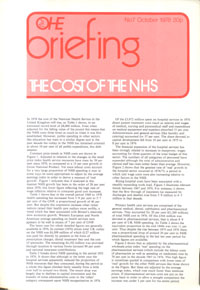In 1978 the cost of the National Health Service in the United Kingdom will rise, to an estimated record level of £8,000 million. Even when adjusted…
In 1978 the cost of the National Health Service in the United Kingdom will rise, to an estimated record level of £8,000 million. Even when adjusted for the falling value of the pound this means that the NHS costs three times as much…
In 1978 the cost of the National Health Service in the United Kingdom will rise, to an estimated record level of £8,000 million. Even when adjusted for the falling value of the pound this means that the NHS costs three times as much as when it was first established. However, public spending in other sectors like education has risen to a similar degree and in the past decade the outlay in the NHS has remained constant at about 10 per cent of all public expenditure, less debt interest.
Current expenditure by volume on all services is projected to increase at an average of 1.7 per cent per year. This level of growth is considerably less than that enjoyed in past years. Within this, expenditure on hospital and community health services, now regulated by ‘cash limits’, will be limited (and is cut in relation to past projections) although even by 1981/82 these services will still be consuming well over three times the revenue resources available to the family practitioner services. Although there is no clear indication as to which of the services will be actually affected by the restraints DHSS guidelines indicate that community based services should be protected.
The cost of family practitioner services is funded centrally mainly because expenditure is influenced by consumer demand. The annual average growth in this sector is projected to rise faster than both hospital and community health services. It is forecast that, in the current financial year, the volume outlay on general medical and pharmaceutical services will rise by 2-4 per cent and 4.5 per cent respectively but that general dental and ophthalmic services will both drop by between 4 per cent and 5 per cent. With the exception of the latter, growth in all services is projected to increase proportionately less in 1978/79 with general dental services showing a continued negative growth. This indicates that any extension of these services will mainly come from financial charges paid by patients.
